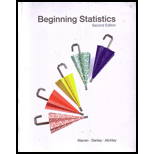
To Construct:
A 99% confidence interval for the percentage of all computer chips from that factory that are not defective
Answer to Problem 12E
Solution:
A 99% confidence interval for the percentage of all computer chips from that factory that are not defective is
Explanation of Solution
Given:
Individual not matching the given characteristic
Confidence level
Description:
A random experiment from a population of size
Based on these numbers, the sample proportion
The sample proportions are binomially distributed (and hence are discrete), which can be approximated using a normal distribution using the continuity correction given that the sample size is large enough
The population proportion is best estimated point-wise by the sample proportion.
The margin of error is defined as the maximum distance from point estimate that the confidence interval covers.
In terms of appropriate
Where
The confidence interval bounds are equidistant from the best point estimate by the amount of margin of error as:
The number of individuals in the sample following the characteristic in the question is divided by the sample size to obtain the sample proportion which is best point estimate to the population proportion.
Then, the margin of error is computed following which, the bounds of interval estimate are obtained from the best point estimate by subtracting and adding respectively margin of error.
Calculation:
The value of
Dividing
Which gives the population proportion estimate.
Since
The critical value is looked up in the standard normal table which yields:
Then the margin of error is:
Rounding off to the
Then, lower bound of confidence interval is:
Rounding off which to the
Then, higher bound of confidence interval is:
Rounding off which to the
Thus, confidence interval is:
Conclusion:
A 99% confidence interval for the percentage of all computer chips from that factory that are not defective is
Want to see more full solutions like this?
Chapter 8 Solutions
Beginning Statistics, 2nd Edition
- please find the answers for the yellows boxes using the information and the picture belowarrow_forwardA marketing agency wants to determine whether different advertising platforms generate significantly different levels of customer engagement. The agency measures the average number of daily clicks on ads for three platforms: Social Media, Search Engines, and Email Campaigns. The agency collects data on daily clicks for each platform over a 10-day period and wants to test whether there is a statistically significant difference in the mean number of daily clicks among these platforms. Conduct ANOVA test. You can provide your answer by inserting a text box and the answer must include: also please provide a step by on getting the answers in excel Null hypothesis, Alternative hypothesis, Show answer (output table/summary table), and Conclusion based on the P value.arrow_forwardA company found that the daily sales revenue of its flagship product follows a normal distribution with a mean of $4500 and a standard deviation of $450. The company defines a "high-sales day" that is, any day with sales exceeding $4800. please provide a step by step on how to get the answers Q: What percentage of days can the company expect to have "high-sales days" or sales greater than $4800? Q: What is the sales revenue threshold for the bottom 10% of days? (please note that 10% refers to the probability/area under bell curve towards the lower tail of bell curve) Provide answers in the yellow cellsarrow_forward
- Business Discussarrow_forwardThe following data represent total ventilation measured in liters of air per minute per square meter of body area for two independent (and randomly chosen) samples. Analyze these data using the appropriate non-parametric hypothesis testarrow_forwardeach column represents before & after measurements on the same individual. Analyze with the appropriate non-parametric hypothesis test for a paired design.arrow_forward
 MATLAB: An Introduction with ApplicationsStatisticsISBN:9781119256830Author:Amos GilatPublisher:John Wiley & Sons Inc
MATLAB: An Introduction with ApplicationsStatisticsISBN:9781119256830Author:Amos GilatPublisher:John Wiley & Sons Inc Probability and Statistics for Engineering and th...StatisticsISBN:9781305251809Author:Jay L. DevorePublisher:Cengage Learning
Probability and Statistics for Engineering and th...StatisticsISBN:9781305251809Author:Jay L. DevorePublisher:Cengage Learning Statistics for The Behavioral Sciences (MindTap C...StatisticsISBN:9781305504912Author:Frederick J Gravetter, Larry B. WallnauPublisher:Cengage Learning
Statistics for The Behavioral Sciences (MindTap C...StatisticsISBN:9781305504912Author:Frederick J Gravetter, Larry B. WallnauPublisher:Cengage Learning Elementary Statistics: Picturing the World (7th E...StatisticsISBN:9780134683416Author:Ron Larson, Betsy FarberPublisher:PEARSON
Elementary Statistics: Picturing the World (7th E...StatisticsISBN:9780134683416Author:Ron Larson, Betsy FarberPublisher:PEARSON The Basic Practice of StatisticsStatisticsISBN:9781319042578Author:David S. Moore, William I. Notz, Michael A. FlignerPublisher:W. H. Freeman
The Basic Practice of StatisticsStatisticsISBN:9781319042578Author:David S. Moore, William I. Notz, Michael A. FlignerPublisher:W. H. Freeman Introduction to the Practice of StatisticsStatisticsISBN:9781319013387Author:David S. Moore, George P. McCabe, Bruce A. CraigPublisher:W. H. Freeman
Introduction to the Practice of StatisticsStatisticsISBN:9781319013387Author:David S. Moore, George P. McCabe, Bruce A. CraigPublisher:W. H. Freeman





